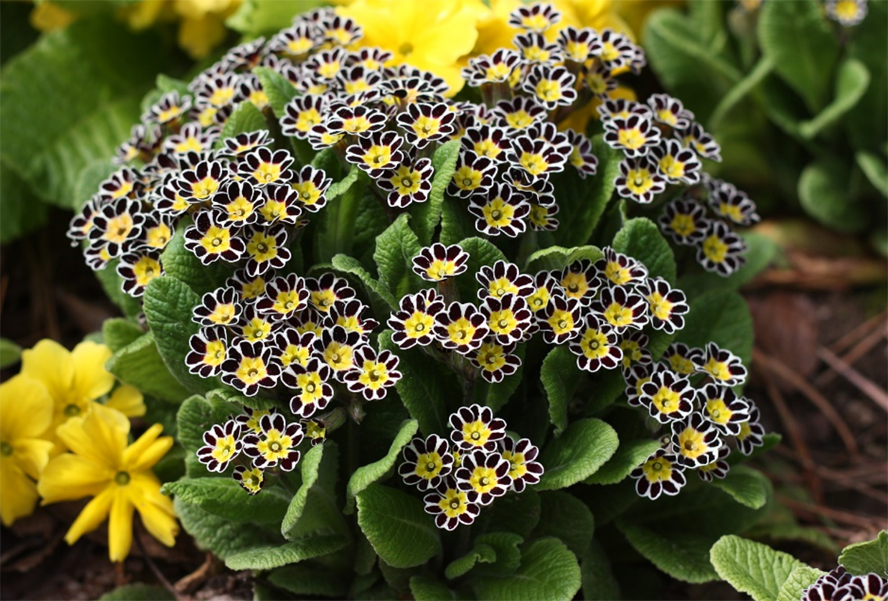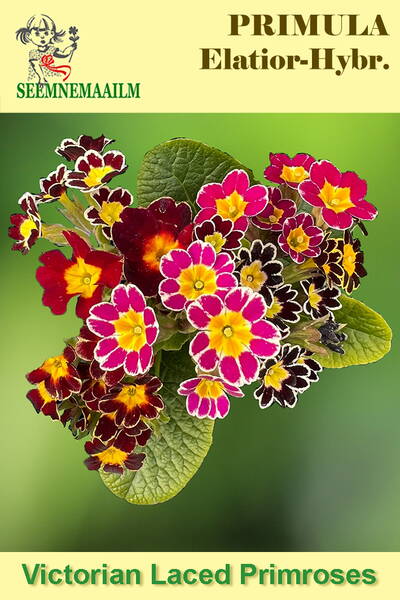Your shopping cart is empty!
Polyanthus primrose "Victorian Laced Primroses"
Polyanthus Primrose "Victorian Lace" (mix) — Primula × polyantha.
Hybrids of the Victorian series are exceptionally hardy, easily enduring even severe winters, and are distinguished by their long-lasting and abundant flowering!
This perennial from the family Primulaceae forms an attractive rosette of dark-green, crinkled leaves.
The compact plant, reaching no more than 30 cm in height, produces beautifully colored, fairly large flowers (up to 3 cm in diameter) that are truly mesmerizing.
Ideal for rock gardens, perennial borders, group plantings on lawns, as well as for containers and balcony boxes.
The polyanthus primrose stands out from the tall primrose with its larger, fragrant flowers, gathered in inflorescences 10–30 cm tall with 5–15 blossoms each. It forms a neat, compact clump about 20 cm in diameter. During flowering, plants are covered with large, vividly colored blooms surrounded by lush green foliage.
Hardy and shade-tolerant, this primrose prefers well-lit areas and tolerates transplanting even during flowering.Sowing and planting.
A jewel among primroses!
Growing conditions.
Hybrids of the Victorian series are exceptionally hardy, easily enduring even severe winters, and are distinguished by their long-lasting and abundant flowering!
This perennial from the family Primulaceae forms an attractive rosette of dark-green, crinkled leaves.
The compact plant, reaching no more than 30 cm in height, produces beautifully colored, fairly large flowers (up to 3 cm in diameter) that are truly mesmerizing.
Ideal for rock gardens, perennial borders, group plantings on lawns, as well as for containers and balcony boxes.
The polyanthus primrose stands out from the tall primrose with its larger, fragrant flowers, gathered in inflorescences 10–30 cm tall with 5–15 blossoms each. It forms a neat, compact clump about 20 cm in diameter. During flowering, plants are covered with large, vividly colored blooms surrounded by lush green foliage.
Hardy and shade-tolerant, this primrose prefers well-lit areas and tolerates transplanting even during flowering.
Sowing and planting.
Sow seeds outdoors in autumn or spring after stratification in moist sand at a low positive temperature for 3–4 weeks. At a soil temperature of +10°C, seedlings appear in about 25 days.
Transplant to a permanent site in spring or autumn of the second year. Plant closely so that no open space remains between leaf rosettes. Young plants flower in their second year.
Flower colors: red, purple, or dark brown with a golden or silvery edge.
Flowering period: April–May.
Hardiness zones: Z5–Z8.
Used for borders, flowerbeds, and rock gardens, as well as for winter forcing. Plants transplanted into pots in autumn will bloom indoors in March–April.

A jewel among primroses!
Enchantingly graceful and dazzlingly beautiful, the primroses of the Victorian series are truly unique. Everything about this variety is special: vigorous growth, a compact, elegant leaf rosette, very early, abundant, and long-lasting flowering, and blossoms that resemble tiny jewels set in fine filigree. In addition to its decorative qualities, this species has a delightful fragrance.
Primroses thrive both in single plantings and in groups under trees or decorative shrubs, in rock gardens or near ornamental ponds. Also ideal for container growing.
Growing conditions.
Sowing: February–April for seedlings. Seeds require preliminary stratification: sow (press lightly into the soil), moisten with a sprayer, cover with glass, and place in a refrigerator at +5…+7°C. Keep under these conditions for 7–10 days, then move to room temperature. Monitor soil moisture carefully. At +18…+20°C, seedlings emerge within 10–14 days. Transplant when they develop 2–3 true leaves. Plant outdoors after spring frosts.
Care: prefers partial shade and loose, fertile, moderately moist soil. For prolonged and abundant flowering, ensure regular watering, weeding, loosening, and feeding. In winter, lightly mound soil around the plants to prevent frost heaving. Can remain in the same location for up to 5 years.
Flowering: April–June in the second year, with possible reblooming in September. Pairs beautifully with daffodils, scillas, and muscari.
Bot. syn.: Primula veris × Primula vulgaris; Primula ×brevistyla DC.












